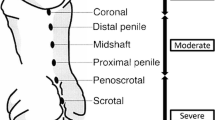Abstract
The aim of this population-based case-control study was to examine the risk of isolated hypospadias in boys born to mothers who have used oral contraceptives in early pregnancy. The study was based on data from the Hungarian Case-Control Surveillance of Congenital Abnormalities from 1980 to 1996, and included 3,038 boys with hypospadias (cases), 24,799 boys without congenital abnormalities (CA-free controls), and 11,881 boys with abnormalities other than hypospadias. We used unconditional logistic regression to adjust for birth order, maternal age, maternal employment status, maternal diabetes, and pre-eclampsia. When comparing cases with CA-free controls the OR for maternal use of OC was 1.21 (95% CI: 0.67–2.17). When comparing cases with boys with other abnormalities, the OR for maternal use of OC was 0.83 (95% CI: 0.46–1.50). Our data showed that self-reported maternal use of oral contraceptives during pregnancy was not associated with an increased risk of hypospadias in the offspring.
Similar content being viewed by others
References
Erickson JD. Epidemiology of hypospadias. In: Baskin L (ed), Hypospadias and genital development. Philadelphia, Kluwer Academic/Plenum Publishers, 2004:25–29
Sharpe RM, Skakkebaek NE, 1993 Are oestrogens involved in falling sperm counts and disorders of the male reproductive tract? Lancet 341: 1392–1395
Kim KS, Torres CR Jr, Yucel S, Raimondo K, Cunha GR, Baskin LS, 2004 Induction of hypospadias in a murine model by maternal exposure to synthetic estrogens Environ Res 94: 267–275
Czeizel AE 1996 Vass I: Teratologic surveillance of oral contraceptives in early pregnancy. Adv Contracep Deliv Syst 12: 5139
Källen B, Mastroiacovo P, Lancaster PA, Mutchinick O, Kringelbach M, Martinez-Frias ML, Robert E, Castilla EE, 1991 Oral contraceptives in the etiology of isolated hypospadias Contraception 44: 173–182
Källen B, Winberg J, 1982 An epidemiological study of hypospadias in Sweden Acta Paediatr Scand Suppl 293: 1–21
Rothman KJ, Louik C, 1978 Oral contraceptives and birth defects N Engl J Med 299: 522–524
Calzolari E, Contiero MR, Roncarati E, Mattiuz PL, Volpato S, 1986 Aetiological factors in hypospadias J Med Genet 23: 333–237
Stoll C, Alembik Y, Roth MP, Dott B, 1990 Genetic and environmental factors in hypospadias J Med Genet 27: 559–563
Polednak AP, Janerich DT, 1983 Maternal characteristics and hypospadias: A case-control study Teratology 28: 67–73
Carmichael SL, Shaw GM, Laurent C, Croughan MS, Olney RS, Lammer EJ, 2005 Maternal progestin intake and risk of hypospadias Arch Pediatr Adolesc Med 159: 957–962
Czeizel AE, Rockenbauer M, Siffel Cs, Varga E, 2001 Description and mission evaluation of the Hungarian case-control surveillance of congenital abnormalities, 1980–1996 Teratology 63: 176–185
Czeizel AE, 1997 The first 25 years of the Hungarian congenital abnormality registry Teratology 55: 299–305
Acs N, Banhidy F, Puhó E, Czeizel AE, 2005 Maternal influenza during pregnancy and risk of congenital abnormalities in offspring birth defects research Birth Defects Res A Clin Mol Teratol 73: 989–96
Sørensen HR, 1953 Hypospadias with special reference to aetiology. Munksgaard Copenhagen
Rockenbauer M, Olsen J, Czeizel AE, Pedersen L, Sørensen HT, 2001 Recall bias in a case-control surveillance system on the use of medicine during pregnancy Epidemiology 12: 461–466
Nielsen GL, Nørgard B, Puho E, Rothman KJ, Sørensen HT, Czeizel AE, 2005 Risk of specific congenital abnormalities in offspring of women with diabetes Diabet Med 22:693–696
Sørensen HT, Pedersen L, Nørgaard M, Wogelius P, Rothman KJ, 2005 Maternal asthma, preeclampsia and risk of hypospadias Epidemiology 16: 806–807
Mitchell AA, 2003 Systematic identification of drugs that cause birth defects–a new opportunity N Engl J Med 349:2556–2559
Heinonen OP, Slone D, Monson RR, Hook EB, Shapiro S, 1977 Cardiovascular birth defects and antenatal exposure to female sex hormones N Engl J Med 296: 67–70
Cuckle HS, Wald NJ, 1982 Evidence against oral contraceptives as a cause of neural-tube defects Br J Obstet Gynaecol 89: 547–549
Czeizel AE, Kodaj I, 1995 A changing pattern in the association of oral contraceptives and the different groups of congenital limb deficiencies Contraception 51: 19–24
Drongowski RA, Smith RK Jr, Coran AG, Klein MD, 1991 Contribution of demographic and environmental factors to the etiology of gastroschisis: a hypothesis Fetal Diagn Ther 6: 14–27. Review
Harlap S, Shiono PH, Ramcharan S, 1985; Congenital abnormalities in the offspring of women who used oral and other contraceptives around the time of conception Int J Fertil 30:39–47
Harlap S, Eldor J, 1980; Births following oral contraceptive failures Obstet Gynecol 55: 447–452
Czeizel AE, Toth J, Erodi E, 1979; Aetiological studies of hypospadias in Hungary. Hum Hered 29:166–171
Czeizel AE, Huiskes N, 1988; A case-control study to evaluate the risk of congenital abnormalities as a result of allylestrenol therapy during pregnancy Clin Ther 10: 725–739
Czeizel AE, Toth J, 1990; A correlation between the birth prevalence of isolated hypospadias and parental subfertility Teratology 41: 167–172
Czeizel AE, Rothman KI, 2002; Does relaxed reproductive selection explain the decline in male reproductive health? A new hypothesis Epidemiology 13: 113–114
Fairfield KM, Fletcher RH, 2002; Vitamins for chronic disease prevention in adults: scientific review JAMA 287: 3116–3126. Review
Author information
Authors and Affiliations
Corresponding author
Rights and permissions
About this article
Cite this article
Wogelius, P., Horváth-Puhó, E., Pedersen, L. et al. Maternal use of oral contraceptives and risk of hypospadias – a population-based case-control study. Eur J Epidemiol 21, 777–781 (2006). https://doi.org/10.1007/s10654-006-9067-0
Received:
Accepted:
Published:
Issue Date:
DOI: https://doi.org/10.1007/s10654-006-9067-0




